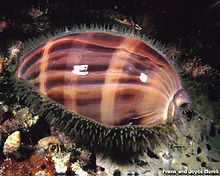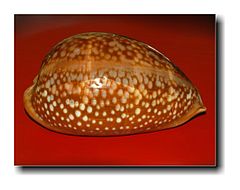- Macrocypraea cervus
-
Macrocypraea cervus 
Living Macrocypraea cervus Scientific classification Kingdom: Animalia Phylum: Mollusca Class: Gastropoda (unranked): clade Caenogastropoda
clade Hypsogastropoda
clade LittorinimorphaSuperfamily: Cypraeoidea Family: Cypraeidae Genus: Macrocypraea Subgenus: Cypraeinae Species: M. cervus Binomial name Macrocypraea cervus
(Linnaeus, 1771)Synonyms - Cypraea cervus (Linnaeus, 1771)
- Cypraea bifasciata Gmelin, 1791
- Cypraea oculata Gmelin, 1791
- Cypraea meleagris Röding, 1798
- Cypraea cervina Lamarck, 1822
- Cypraea jousseaumei Vayssière, 1905
- Macrocypraea peilei Schilder, 1932
Macrocypraea cervus, the 'Atlantic Deer Cowrie', is a species of sea snail, a cowry, a marine gastropod mollusk in the family Cypraeidae, the cowries.
Contents
Distribution
This species is mainly distributed in the tropical Atlantic Ocean and in the Caribbean Sea, in the waters along South Carolina, Florida, Mexico, Brazil, Cuba and Bermudas.
Description
This species is one of the largest cowries and it is quite similar in shape and colour to Macrocypraea cervinetta, but its size is much bigger. The maximum recorded shell length is 190 millimetres (7.5 in), while minimum length is about 40 millimetres (1.6 in).
This cowry is elongated, its basic colour is light brown, with small whitish ocellated spots on the dorsum, like a young fawn (hence the Latin name cervus, meaning 'deer'). Juveniles are without spots. The dorsum shows also a few trasversal clearer bands and a longitudinal line where the two edges of the cowrie mantle meet. The apertural teeth is dark brown. The mantle of the living cowries is dark greyish and completely covered by short fringes.
Habitat
Living cowries can mainly be encountered under corals and rocks in shallow waters at a maximum depth of 35 m. They feed on algae.
References
- Welch J. J. (2010) - "The “Island Rule” and Deep-Sea Gastropods: Re-Examining the Evidence" - Simon Joly, McGill University, Canada
External links
This Cypraeidae-related article is a stub. You can help Wikipedia by expanding it.

